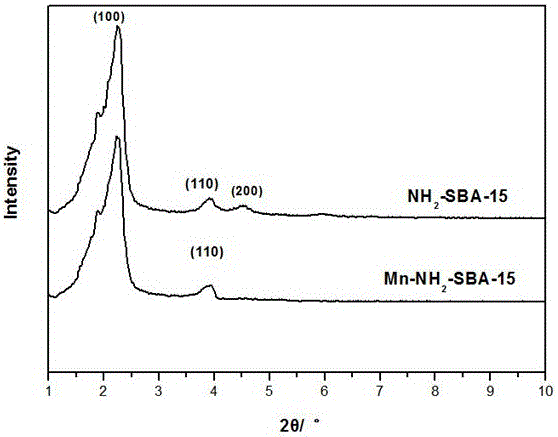Organic-inorganic hybrid mesoporous catalyst for purifying VOCs (volatile organic compounds) and method for preparing organic-inorganic hybrid mesoporous catalyst
A catalyst and inorganic technology, applied in the field of organic-inorganic hybrid mesoporous catalyst and its preparation, can solve the problems of easy volatilization and sintering of active components, high complete conversion temperature, low light-off temperature, etc. Catalytic performance, uniform distribution of functional groups, and not easy to deactivate
- Summary
- Abstract
- Description
- Claims
- Application Information
AI Technical Summary
Problems solved by technology
Method used
Image
Examples
Embodiment 1
[0039] (1) Mix 1.0g of surfactant triblock copolymer P123, 50mL of 1.0mol / L KCl solution, 120mL of 2mol / L hydrochloric acid solution, and 30mL of absolute ethanol, and stir until clear at room temperature to fully dissolve the solid .
[0040] (2) Then add 1g of 1,3,5-trimethylbenzene (TMB) and stir magnetically at 40°C for 30 minutes, then add 4g of tetraethyl orthosilicate (TEOS) and 1mmol of phenyltriethoxysilane in sequence, and use ultrasonic Vibration assisted mechanical stirring for 1h.
[0041] (3) The reaction solution obtained in step (2) was transferred to an autoclave for crystallization at 100°C for 24 hours.
[0042] (4) Suction filter the reaction product obtained in step (3), wash with distilled water at a temperature of 60°C, and vacuum-dry at 60°C for 6 hours. / V (concentrated hydrochloric acid) = 50, concentrated hydrochloric acid (36wt%)) was refluxed for 12 hours, repeated twice, and washed twice with absolute ethanol, dried in vacuum at 60°C for 6 hour...
Embodiment 2
[0046] (1) Mix 3g of surfactant triblock copolymer P123, 80mL of 1.0mol / L NaCl solution, 50mL of 2mol / L hydrochloric acid solution, and 50mL of absolute ethanol, and stir until clear at room temperature to fully dissolve the solid.
[0047] (2) Then add 0.5g of 1,3,5-trimethylbenzene (TMB) and stir magnetically at 40°C for 60 minutes, then add 5g of tetraethyl orthosilicate (TEOS) and 1.5mmol of aminopropyltriethoxysilane in sequence , using ultrasonic vibration to assist mechanical stirring for 2h.
[0048] (3) The reaction solution obtained in step (2) was transferred to an autoclave for crystallization at 100°C for 24 hours.
[0049] (4) Suction filter the reaction product obtained in step (3), wash with distilled water at a temperature of 60°C, and vacuum-dry at 70°C for 4 hours. / V (concentrated hydrochloric acid) = 50, concentrated hydrochloric acid (38wt%)) was refluxed for 12 hours, repeated twice, and washed twice with absolute ethanol, dried in vacuum at 70°C for 4...
Embodiment 3
[0053] (1) Mix 5.0g of surfactant triblock copolymer P123, 65mL of 1.0mol / L KCl solution, 85mL of 2mol / L hydrochloric acid solution, and 40mL of absolute ethanol, stir until clear at room temperature, and fully dissolve the solid .
[0054] (2) Then add 0.75g of 1,3,5-trimethylbenzene (TMB) and stir magnetically at 40°C for 45 minutes, then add 5g of tetraethyl orthosilicate (TEOS), 1.25mmol of mercaptopropyltrimethoxysilane, Mechanical stirring was assisted by ultrasonic vibration for 1 h.
[0055] (3) The reaction solution obtained in step (2) was transferred to an autoclave for crystallization at 150°C for 12 hours.
[0056] (4) Suction filter the reaction product obtained in step (3), wash with distilled water at a temperature of 80°C, and vacuum-dry at 80°C for 4 hours. / V (concentrated hydrochloric acid) = 50, concentrated hydrochloric acid (37wt%)) was refluxed for 12 hours, repeated twice, and washed twice with absolute ethanol, dried in vacuum at 80°C for 4 hours, ...
PUM
| Property | Measurement | Unit |
|---|---|---|
| specific surface area | aaaaa | aaaaa |
| pore size | aaaaa | aaaaa |
Abstract
Description
Claims
Application Information
 Login to View More
Login to View More - R&D
- Intellectual Property
- Life Sciences
- Materials
- Tech Scout
- Unparalleled Data Quality
- Higher Quality Content
- 60% Fewer Hallucinations
Browse by: Latest US Patents, China's latest patents, Technical Efficacy Thesaurus, Application Domain, Technology Topic, Popular Technical Reports.
© 2025 PatSnap. All rights reserved.Legal|Privacy policy|Modern Slavery Act Transparency Statement|Sitemap|About US| Contact US: help@patsnap.com

